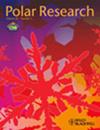Can you hear me? Impacts of underwater noise on communication space of adult, sub-adult and calf contact calls of endangered St. Lawrence belugas (Delphinapterus leucas)
IF 1.3
4区 地球科学
Q3 ECOLOGY
引用次数: 11
Abstract
Noise and anthropogenic disturbances from vessel traffic are an important threat to the recovery of the endangered St. Lawrence Estuary (SLE) beluga population. The consequences of acoustic masking could be particularly adverse in the case of critical vocalizations that maintain contact between mothers and their dependent but mobile calves. This study models the communication range of adults, sub-adults and newborn beluga contact calls in the presence and absence of vessels in an important summering area for this population. Ambient noise measurements, a composite beluga audiogram and apparent source levels of adult/sub-adult and newborn calls, informed the model. Apparent source levels were estimated from received levels of contact calls produced by four individuals carrying digital acoustic tags in the SLE, Canada, and from received levels of calls recorded from two adults and a newborn calf at an aquarium, at known distances from a calibrated hydrophone. The median communication ranges were over 18 times larger for SLE adult and sub-adult calls than for newborn calls, with a 57 and 53% reduction in range in the presence of vessel noise, respectively. For newborn calls, this results in a median range of 170 m in vessel noise. These first estimates of the communication range of beluga vocalizations with a known function suggest that masking of the quiet calls of newborns by anthropogenic noise could impair mother–calf contact.你能听到我说话吗?水下噪声对濒危圣劳伦斯白鲸成虫、亚成虫和幼崽接触叫声交流空间的影响
来自船舶交通的噪音和人为干扰是威胁濒临灭绝的圣劳伦斯河口白鲸种群恢复的重要因素。声掩蔽的后果可能特别不利的情况下,关键的发声,保持母亲和他们的依赖,但移动的小牛之间的联系。这项研究模拟了成年白鲸、亚成年白鲸和新生白鲸在一个重要的夏季区域有船只和没有船只的情况下的交流范围。环境噪声测量、合成白鲸听音图以及成年/亚成年和新生儿呼叫的明显来源水平为模型提供了信息。根据在加拿大SLE中携带数字声学标签的四个个体产生的接触呼叫的接收水平,以及在距离校准的水听器已知距离的水族馆中从两个成年人和一个新生牛犊接收的呼叫水平估计了明显的源水平。SLE成虫和亚成虫呼叫的中位通信范围比新生儿呼叫大18倍以上,在存在血管噪声的情况下,范围分别减少了57%和53%。对于新生儿的叫声,这导致船只噪音的中位数范围为170米。这些对已知功能的白鲸发声交流范围的初步估计表明,人为噪音掩盖了新生儿的安静叫声,可能会损害母鲸与幼鲸的接触。
本文章由计算机程序翻译,如有差异,请以英文原文为准。
求助全文
约1分钟内获得全文
求助全文
来源期刊

Polar Research
地学-地球科学综合
CiteScore
3.20
自引率
5.30%
发文量
22
审稿时长
>12 weeks
期刊介绍:
Since 1982, Polar Research has been the international, peer-reviewed journal of the Norwegian Polar Institute, Norway''s central institution for research, environmental monitoring and mapping of the polar regions. Aiming to promote the exchange of scientific knowledge about the Arctic and Antarctic across disciplinary boundaries, Polar Research serves an international community of researchers and managers. As an open-access journal, Polar Research makes its contents freely available to the general public.
Original primary research papers comprise the mainstay of Polar Research. Review articles, brief research notes, letters to the editor and book reviews are also included. Special issues are published from time to time.
The scope of Polar Research encompasses research in all scientific disciplines relevant to the polar regions. These include, but are not limited to, the subfields of biology, ecology, geology, oceanography, glaciology and atmospheric science. Submissions from the social sciences and those focusing on polar management and policy issues are welcome. Contributions about Antarctica are particularly encouraged.
 求助内容:
求助内容: 应助结果提醒方式:
应助结果提醒方式:


